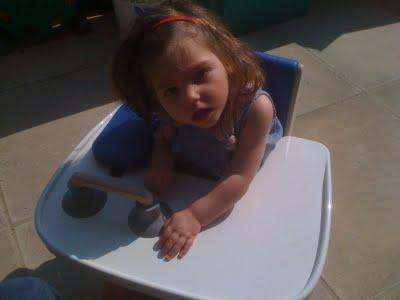They were a long time in coming. Although the scans actually took seven working days to process, given the complexities of Isobel's brain injury there was much to report, so for necessity’s sake went to her paediatrician instead.
 In the absence of illustrations, please excuse me for getting technical. Such is the enormity of the situation we are facing today that I only hope you are sitting down with a cup of tea or coffee while reading this. For reasons that I will have to expand on at another time, I detest the word ‘normal’, but given the medical context I hope you will also excuse its use on this occasion.
In the absence of illustrations, please excuse me for getting technical. Such is the enormity of the situation we are facing today that I only hope you are sitting down with a cup of tea or coffee while reading this. For reasons that I will have to expand on at another time, I detest the word ‘normal’, but given the medical context I hope you will also excuse its use on this occasion.On Dr Mallya’s screen were two sets of monochromatic scans, the first of which was created when Isobel was ten days old, and still in hospital. Because of the evolving nature of CP, it was necessary to show how this set contrasted with the more recent scans.
In the first scan, taken from the back, almost the whole of her brain area showed up as dark gray – normal. It was outlined first in black, then a thin white line representing the skull. The gap between that and the brain was filled with cerebral fluid, which acts as a stabiliser when someone knocks his or her head. In normal circumstances, as the skull and the brain grew, that gap would have remained consistent in width and as it stood, was also normal.
Right at the top of the nape of the neck lay two small outlying curls of white: the 'brain within a brain,' the cerebellum. Closer scrutiny revealed that its left side was slightly askew - the result of a lack of oxygen at birth. But at that stage, no-one could tell how that was going to affect the rest of the brain: the actual affected parts were beyond microscopic. Dr Mallya demonstrated how something as simple as twiddling your thumbs demands a signal from the brain that is impossible to pinpoint at source in a newborn, so blank a canvas is his or her brain at that point. Diagnosis would have been out of the question.
Two years on, it was a shock to see how the injury had evolved. Dr Mallya showed three cross-sections of the brain, looking down. Here, we could clearly see how the tightening grip of CP had widened the gap between brain and skull - hence the microcephaly. There was even a tiny pool of cerebral fluid in the left side where her brain should have been.
At Isobel’s age, again in normal circumstances her brain would have been more cabbage-like in appearance and showing up as completely dark gray in the scan. That was still evident, except that the white parts that once resided in the cerebellum had now shifted towards the front of the brain: the motor regions. They were etched into both sides more sharply than before, more on the left than on the right, becoming more pronounced as you drew closer to the temples - a little like the thick white rind on bacon rashers. They confirmed that Isobel was not hemiplegic as originally thought (I’d hoped it was mainly concentrated in her right arm) but quadriplegic. The prospect of her walking, once so promising, now looked uncertain.
More was to come. In another cross-section – this time, from the side – the front part of the brain appeared smooth in contrast to the far curlier back. This signified that Isobel's cognition had been severely damaged by her seizures, meaning that she could have memory problems, impacting directly on the long-term development of her speech and language (including her signing), fine and gross motor skills, and learning progress. Although the seizures had been absent for nearly a year now, given the extent of the cognitive damage Dr Mallya could not possibly risk decreasing her medication. That pesky twice-daily routine would have to continue indefinitely.
This piece of news hurt Miles. We’d both banked so much on our little girl's joie de vivre, believing that she could be a much brighter person than her medical reports had indicated. Yet once again, we were left feeling she’d been robbed – not just of her physical freedom this time, but also her intellectual freedom. How would she stand up to the oppressors she was sure to meet in her lifetime? By way of reassurance, Dr Mallya stressed that the scans were just a guide and did not reflect on the progress she was making. But not even he could ignore how pale Miles’ face had become with quiet incandescence.
Not that we were blaming him for Isobel's disability, of course; we’d always valued his clear input and measured, calm manner. Nevertheless, we both felt an overwhelming sense of injustice. Every parent who has just received news of his or her child’s disability feels this, I am sure. But in our case it felt especially marked, for reasons that only deaf parents of disabled children can empathise with. In our situation, the barriers do come up doubly hard.
That is not to say we no longer believe in Isobel. She has far too much life and personality for us to give up that easily. Every time we look into her eyes, we still wonder: is there more going on in that pretty head of hers than she’s able to say? Maybe she is, but right now, it seems that hope - and the positive thinking that usually befriends it - is proving harder to maintain than we previously thought.

